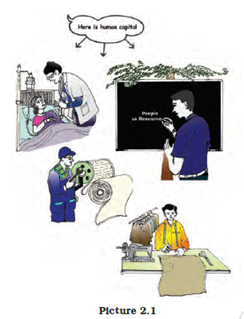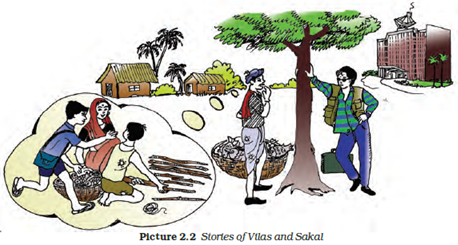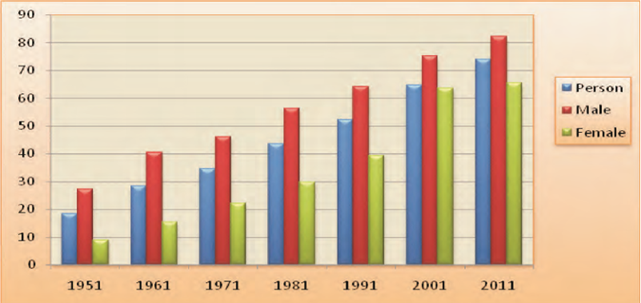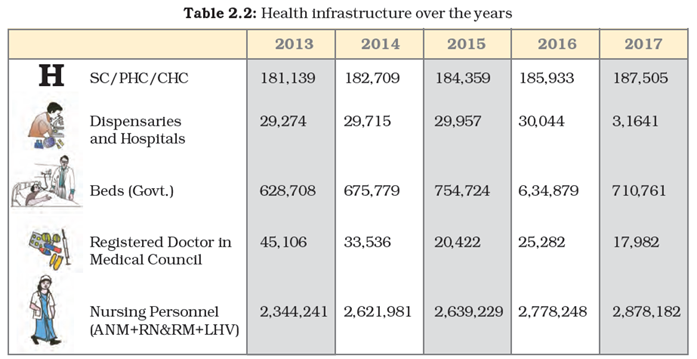NCERT Solutions for Class 9 Economics Chapter 2 People as Resource
NCERT Solutions for Class 9 Social Science Economics Chapter 2 People as Resource contain answers to the textbook exercise questions. The NCERT solutions are easy and accurate that helps with the questions asked in the examinations. These solutions cover all the questions of the chapter in detail. NCERT Solutions for Class 9 Social Science Economics Chapter 2 are prepared by our subject experts in very easy language. All our solutions are updated as per the latest CBSE Syllabus and Guidelines.
Class 9 Social Science Economics Chapter 2 NCERT Solutions
Let’s Discuss Page no. 17
Question 1: Looking at the photograph can you explain how a doctor, teacher, engineer and a tailor are an asset to the economy?

Answer: (i) A population becomes human capital when there is investment made in the form of education training and medical care.
(ii) Human capital is the stack of skills and productive knowledge embodied in them.
(iii) Investment made in the form of education and training in making a doctor, a teacher an engineer and a tailor, has increased their capabilities of providing different services to the people of the country and therefore they are an asset to the economy of a nation
Let’s Discuss Page no. 18
Question 1: Do you notice any difference between the two friends? What are those?

Answer: The differences between the two friends Sakal and Vilas were
(i) Vilas father died when Vilas was two years old whereas Sakal was living with his parents.
(ii) Sakal went to school but Vilas did not go to school.
(iii) Sakal was interested in studies whereas Vilas was not interested in studies.
(iv) Sakal did a course in computers and became employed whereas Vilas remained illiterate and was not employed
(v) The condition of Sakal and his family became better whereas Vilas and his family lived in poverty.
Let’s Discuss Page no. 21
Study the graph and answer the following questions:

Question 1: Has the literacy rates of the population increased since 1951?
Answer: Yes, the literacy rates of the population have increased since 1951 as shown below.
Question 2: In which year India has the highest literacy rates?
Answer: India has the highest literacy rates in 2001.
Question 3: Why literacy rate is high among the males of India?
Answer: India traditionally has a patriarchal male dominated society where more importance is given to males. Culturally due to division of labour the males go out of their homes and get better access to education. Poor families due to monetary constraints prefer to send only their sons to school and not their daughters.
Question 4: Why are women less educated than men?
Answer: Women are less educated than men because more preference is given to the boys or sons in the family for education as they are considered as future of the family. Traditionally, the girls were expected to stay at home and look after domestic chores. So, education among girls was not encouraged. Because, of the above reasons the women are less educated than men.
Question 5: How would you calculate literacy rate in India?
Answer: The literacy rate can be calculated on the basis of the formula i.e., the number of literate people divided by the population multiplied by 100.
Question 6: What is your projection about India’s literacy rate in 2020?
Answer: The projection about India’s literacy rate in year 2010 would be between 75% to 85%.
Let’s Discuss Page no. 23
Discuss this table in the classroom and answer the following questions.

Question 1: Is the increase in the number of colleges adequate to admit the increasing number of students?
Answer: No, the increase in the number of colleges is not adequate to admit the increasing number of students because the number of students is increasing at a faster rate compared to the colleges being established.
Question 2: Do you think we should have more number of universities?
Answer: Seeing the ever increasing number of students, we should establish more universities to cater to their needs. But at the same time greater stress should be on opening more and more colleges.
Question 3: What is the increase noticed among the teachers in the year 1998–99.
Answer: There was an increase of 21 thousand teachers in the year 1998-99 compared to 1996- 97.
Question 4: What is your idea about future colleges and universities?
Answer: In future colleges and universities, stress should be on vocationalisation of education. There should also be a focus on distance education, and convergence of formal and informal, distance and IT education institutions. Colleges should be set up in rural areas to benefit the rural students. Colleges and universities should focus on providing student centered education.
Let’s Discuss Page no. 23-24
Study Table 2.2 and answer the following questions.

Question 1: What is the percentage increase in dispensaries from 1951 to 2015?
Answer: Missing
Question 2: What is the percentage increase in doctors and nursing personnel from 1951 to 2015?
Answer: Missing
Question 3: Do you think the increase in the number of doctors and nurses is adequate for India? If not, why?
Answer: No, the increase in the number of doctors and nurses is Inadequate because the ratio of both doctors and nursing personnel is still too low for India’s population.
Question 4: What other facilities would you like to provide in a hospital?
Answer: Other facilities we would like to provide in a hospital — (i) Hospitals should be spotlessly clean and hygienic.
Question 5: Discuss about the hospital you have visited?
Answer: I have visited the Anand Hospital in our city
(i) It is a 200 bed multi specialist hospital and provides high class medical facilities.
(ii) It has state of the art operation theatres
(iii) It has various machines to carry out different kinds of tests like ultrasound, blood bank. MRI, etc.
(iv) It has a well equipped pathology lab.
(v) It has a number of specialists in different branches of medicine.
(vi) It caters to the needs of the entire city and also to the surrounding rural areas.
(vii) It is centrally air conditioned. It also has a medical store.
(viii) The only drawback is that being a private hospital the treatment for the patients is costly.
Question 6: Can you draw a graph using this table
Answer: Do it yourself.
Exercises
Question 1: What do you understand by ‘people as a resource’?
Answer: People who are part of the workforce are called human resource. By contributing in productivity, the human resource plays a significant role in the economy of a country. Any other resource becomes useful only because of the input by the human resource.
Question 2: How is human resource different from other resources like land and physical capital?
Answer: Human resource makes use of other resources like land and physical capital to produce an output. The other resources cannot become useful on their own. This is the reason why human resource is considered to be superior to the other resources.
Question 3: What is the role of education in human capital formation?
Answer: Education plays an important role in human capital formation. Education improves the quality of human resources. An educated person is likely to contribute to the economy in a better way than an uneducated person. We should keep in mind that education does not only mean a formal education to obtain degrees but also means skill development.
Or
Education is the most important component of human resource development.
- Proper education and training enable the formation of this human capital. An educated population is an asset, a resource.
- Education enhances the quantity and quality of individual productivity, which in turn adds to the growth of the economy.
- It develops personality and sense of national consciousness among the people which are important for rapid economic growth.
Question 4: What is the role of health in human capital formation?
Answer: Health plays an important role in human capital formation. A healthy person is more likely to realize his full potential and can become an asset for the economy. An unhealthy person is less likely to realize his potential and can become a liability for the economy.
Question 5: What part does health play in the individual’s working life?
Answer: A healthy person will not have to take frequent breaks from his work. By working on full schedule, a healthy person can improve his earnings and can live a better life. Moreover, he will also be in a position to save on medical bills. The money thus saved can be utilised for creating some assets.
Question 6: What are the various activities undertaken in the primary sector, secondary sector and tertiary sector?
Answer: The different activities were classified into three major sectors i.e. primary, secondary, and tertiary. The primary sector includes agriculture, forestry, livestock, fishing, poultry, and mining. In the secondary sector is included the quarry and manufacturing. The tertiary sector includes trade, transport, communication, finance, education, health, tourism, utilities, insurance, etc.
Question 7: What is the difference between economic activities and non-economic activities?
Answer: Activities that add value to the national income are called economic activities. These have two parts – market activities (production for pay or profit) and non-market activities (production for self-consumption).
Non-economic activities are the ones that do not add to the national income; for example, an individual performing domestic chores.
Question 8: Why are women employed in low paid work?
Answer: Education and skill are the major determinants of the earning of any individual in the market. Due to gender discrimination, women are generally denied the education and the necessary skills to become worthy contributors to the national income. As a result, a majority of women have low education and skill formation. This is one of the reasons why they get paid less than men.
Question 9: How will you explain the term unemployment?
Answer: Unemployment is a situation in which people who are able and willing to work at the going wages cannot find jobs.
An individual is termed as unemployed if he or she is part of the workforce of a country, and is capable and willing to work for payment, but is unable to do so.
Question 10: What is the difference between disguised unemployment and seasonal unemployment?
Answer: Disguised unemployment: When more persons are working in a job than actually required, the situation is termed as disguised unemployment. For example, if in an agricultural activity eight people are engaged but this work/activity actually requires the services of five people, then three persons are extra. If these three people out of eight are withdrawn, total production will remain unaffected.
Seasonal unemployment: Seasonal unemployment occurs when people are able to find jobs only during some months of the year. For Example, Agricultural labourers find work only during the busy seasons, i.e., sowing, harvesting, weeding and threshing. This is because of the seasonal character of agriculture in India.
Question 11: Why is educated unemployed, a peculiar problem of India?
Answer: India has a huge population and every year a large number of people graduate from schools and colleges. Employment generation in various sectors is not keeping pace with the number of educated people coming out of educational institutions. Due to this, educated unemployed is a peculiar problem of India.
Question 12: In which field do you think India can build the maximum employment opportunity?
Answer: Given that agriculture is India ‘s backbone, India can create maximum employment opportunities in agriculture-based industries.
Question 13: Can you suggest some measures in the education system to mitigate the problem of the educated unemployed?
Answer: Measures in the education system to mitigate the problem of the educated unemployed:
- Make education at the secondary level more career-oriented, which would endow individuals with not only education but also the requisite skills for gaining successful employment.
- Create a sort of screening process whereby each individual chooses subjects that suit his or her abilities.
- The introduction of newer subjects and fields of study at the school level should be accompanied by a growth of job opportunities in the sectors that would employ the students electing to study such subjects.
Question 14: Can you imagine some village which initially had no job opportunities but later came up with many?
Answer: There can be many examples of such villages. When an infrastructure project or some industry develops near a village, employment generation takes place. Gurgaon can be a very good example. Before the beginning of the Maruti Udyog Limited, Gurgaon used to be a small village. Subsequent development of industry changed the situation in Gurgaon.
Question 15: Which capital would you consider the best — land, labour, physical capital and human capital? Why?
Answer: Human capital makes use of the other resources like land, labour and physical capital to produce an output. The other resources cannot become useful on their own.Hence, human capital may well be considered the best among all the resources.